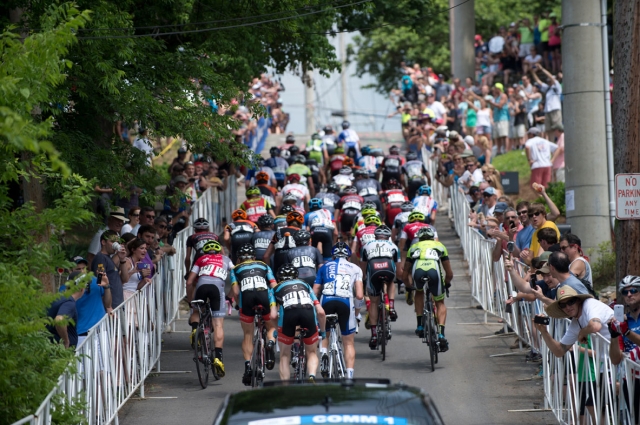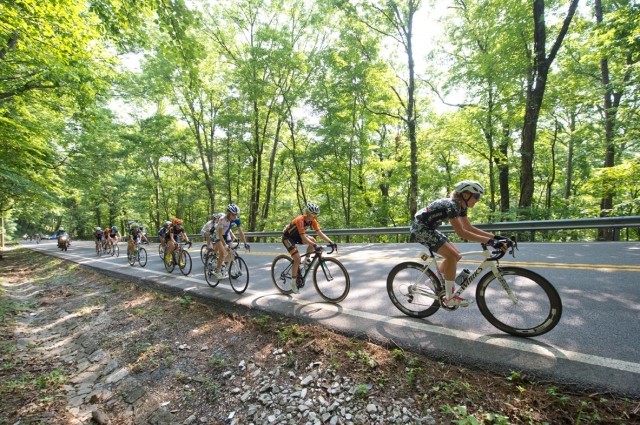| |

Love it or hate it, you've got to climb!
by James Herrera, USA Cycling National BMX Coach

The men's peloton makes the Kent Street hill climb at Professional Road & TT Nationals in Chattanooga. Photo by Casey Gibson
Does this scenario sound familiar? It sure rings true for me, as every group ride in every town, on road or dirt that I’ve ever done has a similar dynamic. I did a brief stint as a math teacher a number of years ago, teaching algebra, geometry, and calculus to high school students, and I noticed a similar dynamic between climbing and math. Some people love it. Some people hate it. That’s just the way it is. Yet, just like I used to tell my students, it doesn’t matter whether you’re one of the haters. You’ve got to practice to get good enough to enjoy a certain level of comfort with it. Because love it or not, if you live in the mountains, you’re going to go uphill. With proper training, you can bank on one thing: you WILL get better at it! Consequently, what you used to hate, you learn to tolerate, and potentially learn to love.
The mechanics of climbing on a bike

The women's peloton heads up Lookout Mountain. Photo by Casey Gibson
Aerobic and muscular conditioning
Next, we have to consider the physiological demands involved, aerobic and muscular conditioning. A highly conditioned aerobic and muscular system allows us to tolerate greater volumes and intensities of work. We can push heavier gears, move at faster speeds, and spend greater amounts of time on the bike. Now let’s look at how this conditioning occurs.
In training, there are three training principles we need to acknowledge: overload, progression, and specificity. When a training stimulus that is greater than what the body is accustomed to is applied, we call this an overload. For example, if your average pace up climb X is 12mph, but today you push yourself to hit 13mph, you’ve accomplished a training overload. The effort may cause extra fatigue and necessitate a bit more rest than usual, but with adequate recovery the body will adapt to the new training load. After a few more overload and recovery bouts, 13mph will become the new norm. Once this occurs, we must adopt the principle of progression and up the ante. It will now take an effort of greater than 13mph to accomplish a training overload. Specificity in training means if you want to be a better climber, you’ve got to climb hills. Doing more time on flatter roads or increasing strength in the gym will help marginally, but definitely don’t avoid the hills.
Proper climbing cadence depends on the individual
Now let’s put it all together. Efficient climbing is the harmonious unity of proper cadence, gearing, leg strength, and aerobic conditioning. While there’s been an extensive amount of field and lab based research to determine proper cadence (85-95 rpm’s is a common prescription for flat ground riding), it truly depends on the individual. Climbing cadences can fluctuate across the spectrum of 65-90 rpm’s. That’s an incredibly large discrepancy, but some riders are much more efficient pushing heavier gears, while others prefer to spin the lighter.
Here’s the magic: In order to be most efficient, you must select a gear that you have the strength to spin comfortably, while maintaining a rhythmic breathing pattern. Simple enough, right? Comfortable cadence and rhythmic breathing are your two keys to success when going uphill. This will insure that you’re managing both your aerobic and muscular energy output, which won’t leave you high and dry before you hit the hill top or the end of your ride.
Finally, let’s look at a few other successful climbing tactics:
- Find your preferred climbing cadence (leg speed). This is easy enough to do with a cycling computer and/or heart rate monitor. Following a warm-up, pedal up a consistent grade that takes at least 10 minutes to climb. You’ll take the hill in three 3-minute segments. Initially, pedal the first three minutes at your typical cadence, gear, and speed for this climb. Check your heart rate and/or note your breathing pattern as you conclude this block. For the next three minute segment, shift one cog easier in the back, increasing your cadence to maintain the same speed. You’ll most likely notice a heart rate and breathing change in the first minute of the effort, but can continue for the three minute duration. Was your heart rate higher or lower? Were you breathing heavier or easier? For the final three minute block, shift two cogs heavy in the back so you’re now in one cog heavier than your original gear. Decrease your cadence to maintain the same speed. Again, note your heart rate and breathing pattern over the three minute trial. Your most efficient climbing cadence is that which is comfortable, and also elicits a lower heart rate and easier breathing pattern.
- Work on muscular strength. For many cyclists, inadequate leg strength is the rate limiting factor in their climbing ability. To get over this hump, perform intervals on hills in a slightly heavier gear than you would typically use. Your cadence will be slower than usual, but your muscles will adapt to the training stimulus if you allow adequate recovery time. You’ll soon be climbing in heavier gears at improved speeds with the same perceived exertion. Try 3 x 8 minutes up your favorite climb in a gear that decreases your preferred cadence by at least 10rpm.
- Climb at your pace. One thing I’ve learned over years of coaching and riding is that you need to climb at your pace, not anyone else’s. Trying to keep up with someone who’s pushing the pace a bit more than you’re comfortable with is going to result in the inevitable “blow up” before you crest the hill. Once you’re in gear, settle into your pace, relax your upper body, and focus on a smooth turnover.
- Practice overload and recovery in training. Challenge yourself. On your favorite hills, employ interval training as a mode of gaining speed and power. Find a climb with a relatively consistent grade that takes approximately 15-20 minutes to climb. Assuming your normal pace is 12mph, try doing two to three 10 minute efforts on that hill at 14mph (or simply up your average 15-20 minute pace by 2-3mph for an interval of half the duration of the climb). Recover on the descent (approximately 5-8 minutes in total) before succeeding efforts. By utilizing overload, recovery, and progression in your training, you’ll eventually increase your average climbing speed.
- Fuel the effort. Here in Colorado, we’ve got some epic climbs to conquer. Some can take minutes while others take hours. It’s no secret that climbing is more energy costly than flat ground or downhill riding. Consequently, digestion can be impaired when we’re working so hard. Remember to fuel in the 15-20 minutes leading up to a climb, and take in approximately 30-60g of carbohydrate per hour for a major effort. Trickle the carbs into the system every 20 to 30 minutes with a combination of energy gels, carb drinks, or foods you know your stomach can tolerate when working at that intensity (a PowerBar Power Gel has 27g of carbohydrate, while PowerBar Endurance drink mix has ~42g of carbs in a 20oz bottle). For multiple big climbs, use drink mixes and gels to fuel while climbing, saving solids for long descents or flats when the GI system doesn’t have to work as hard.
- Regulate your pace. Manage your energy expenditure on longer climbs by saving up for steeper grades on the hill. Throttle back for a few minutes before an extra steep pitch so you’ve got some extra gas in the tank to get you over the hump. This strategy works great in your home area on climbs you’ve done before. When traveling to events, read course profiles to know when the steepest grades will occur. Always keep enough energy to accelerate over the top.
- Don’t be discouraged with your rate of improvement. While there is a genetic predisposition to the magnitude a cyclist can improve, the good news is, we will all improve with proper training! You may not be bound for the 2014 Tour de France or 2016 Olympics in Rio, but you’ll certainly marvel at your newfound speed and fitness.
Remember friends, climbing is cycling. It’s what defines our sport, separates the herd, and lets us take in all the mountains have to offer. Love ‘em or hate ‘em, those mountains aren’t going anywhere. Heed my advice, challenge yourself, and I’ll see you in the mountains.

| |